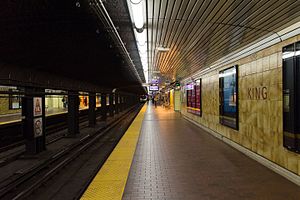King station (Toronto)
 | |||||||||||
| General information | |||||||||||
| Location | 3 King Street East, Toronto, Ontario Canada | ||||||||||
| Coordinates | 43°38′57″N 79°22′40″W / 43.64917°N 79.37778°W | ||||||||||
| Owned by | Toronto Transit Commission | ||||||||||
| Platforms | side platforms | ||||||||||
| Tracks | 2 | ||||||||||
| Connections |
| ||||||||||
| Construction | |||||||||||
| Structure type | underground | ||||||||||
| Accessible | No | ||||||||||
| History | |||||||||||
| Opened | 30 March 1954 | ||||||||||
| Passengers | |||||||||||
| 2023–2024[1] | 35,107 | ||||||||||
| Services | |||||||||||
| |||||||||||
King is a subway station on the Yonge–University line in Toronto, Ontario, Canada. The station is located at the intersection of King and Yonge Streets in Toronto's financial district.[2] Wi-fi service is available at this station.[3]
History

King Station opened in 1954 as part of the first stretch of subway line built in Toronto, between Union and Eglinton stations.[4]
The original address for the station was 70 Yonge Street, which is still used in TTC maps, but the official website uses the address 3 King Street East, which both point to the intersection of the two streets, and the numbers are not used by nearby buildings.
A scissors crossover was installed just north of the station when the line was built, so that trains could easily crossover from one track to another, but was later removed in May 1984 during track rehabilitation because of maintenance costs. In 2012, the TTC decided to put this crossover back, as it would allow trains to turn back during service disruptions, once automatic train control is implemented in 2016.[5]
Station description
The station lies underneath Yonge Street at King Street, and is built on three levels. All five entrances are located on ground level, with three of them being sidewalk staircases from the northeast, southwest, and southeast corners of the Yonge Street and King Street intersection. The other two entrances are located at the entrance to Scotia Plaza, and an automatic one at 21 Melinda Street (Commerce Court East) respectively. There is also an "exit only" sidewalk staircase from the southbound subway platform, just south of Melinda Street.[2] There are no elevators in this station, and it is not accessible for persons with physical disabilities.
Below ground level are two separate concourses, located under King Street (north concourse), and under Commerce Court (south concourse). All entrances and exits connect to the north concourse except for ones along Melinda Street. Below the concourses are the subway platforms, connected by stairs and one escalator to the northbound platform on weekdays from 3:00 pm to 6:30 pm.[6]
There are no tenants located within the station.
Subway infrastructure in the vicinity
North of the station, the subway travels through a scissors crossover through its tunnels underneath Yonge Street, past Queen Street, and into Queen station. South of the station, the subway continues underneath Yonge Street, until it reaches Front Street, where it turns 90 degrees west and passes through a crossover into Union station.
Nearby destinations
The destination for many people using King Station is the financial district and its numerous office towers, connected to the station by the underground PATH system of pedestrian tunnels. These include the Canadian Pacific Building, Scotia Plaza, Commerce Court, Toronto-Dominion Centre and First Canadian Place.
This is also the closest station to One Yonge Street, the The King Edward Hotel, St. James Cathedral, Toronto Sculpture Garden, St. Lawrence Hall and the St. Lawrence Market.
Surface connections

A transfer is required to connect between the subway system and these surface routes:
Streetcars
- 304 King Blue Night eastbound to Broadview Station and westbound to Dundas West Station
- 503 Kingston Rd eastbound to Bingham Loop
- 504 King eastbound to Broadview Station and westbound to Dundas West Station
- 514 Cherry eastbound to Distillery Loop and westbound to Dufferin Gate Loop
Bus routes
- 97B Yonge northbound to Steeles Avenue
- 97B southbound to Queens Quay
- 141 Downtown/Mt Pleasant Express - rushhour only, extra fare required
- 142 Downtown/Avenue Road Express - rushhour only, extra fare required
- 143 Downtown/Beach Express - rushhour only, extra fare required
- 144 Downtown/Don Valley Express - rushhour only, extra fare required
- 145+ Downtown/Humber Bay Express - rushhour only, extra fare required
- 172A Cherry Street eastbound to Carlaw Avenue
- 172B eastbound to Carlaw Avenue via Cherry Beach (Seasonal service)
- 172+ westbound to St. Andrew Station
- 320 Yonge Blue Night northbound to Steeles Avenue
- 320A northbound to York Mills Station
- 320E northbound to Eglinton Station
- 320 southbound to Queens Quay
References
- ^ "Subway ridership, 2023–2024" (PDF). Toronto Transit Commission. Retrieved November 12, 2024.
This table shows the typical number of customer-boardings made on each subway line and the number of customers travelling to and from each station platform on a typical weekday in Sep 2023–Aug 2024.
- ^ a b "TTC King Station". Toronto Transit Commission. Retrieved 21 August 2014.
- ^ "Wi-fi Now Available At". TCONNECT. Retrieved January 2015.
Each of the 65 underground stations will have wireless and Wi-Fi service by 2017
{{cite web}}: Check date values in:|accessdate=(help) - ^ "A Cavalcade of Progress, 1921-1954". Toronto Transit Commission. 1954. Retrieved May 2013.
{{cite web}}: Check date values in:|accessdate=(help) - ^ Bow, James. "A History of the Original Yonge Subway". Transit Toronto. Retrieved 21 August 2014.
- ^ "TTC King Station - Elevators and Escalators". Toronto Transit Commission. Retrieved 21 August 2014.
External links
![]() Media related to King Station at Wikimedia Commons
Media related to King Station at Wikimedia Commons


